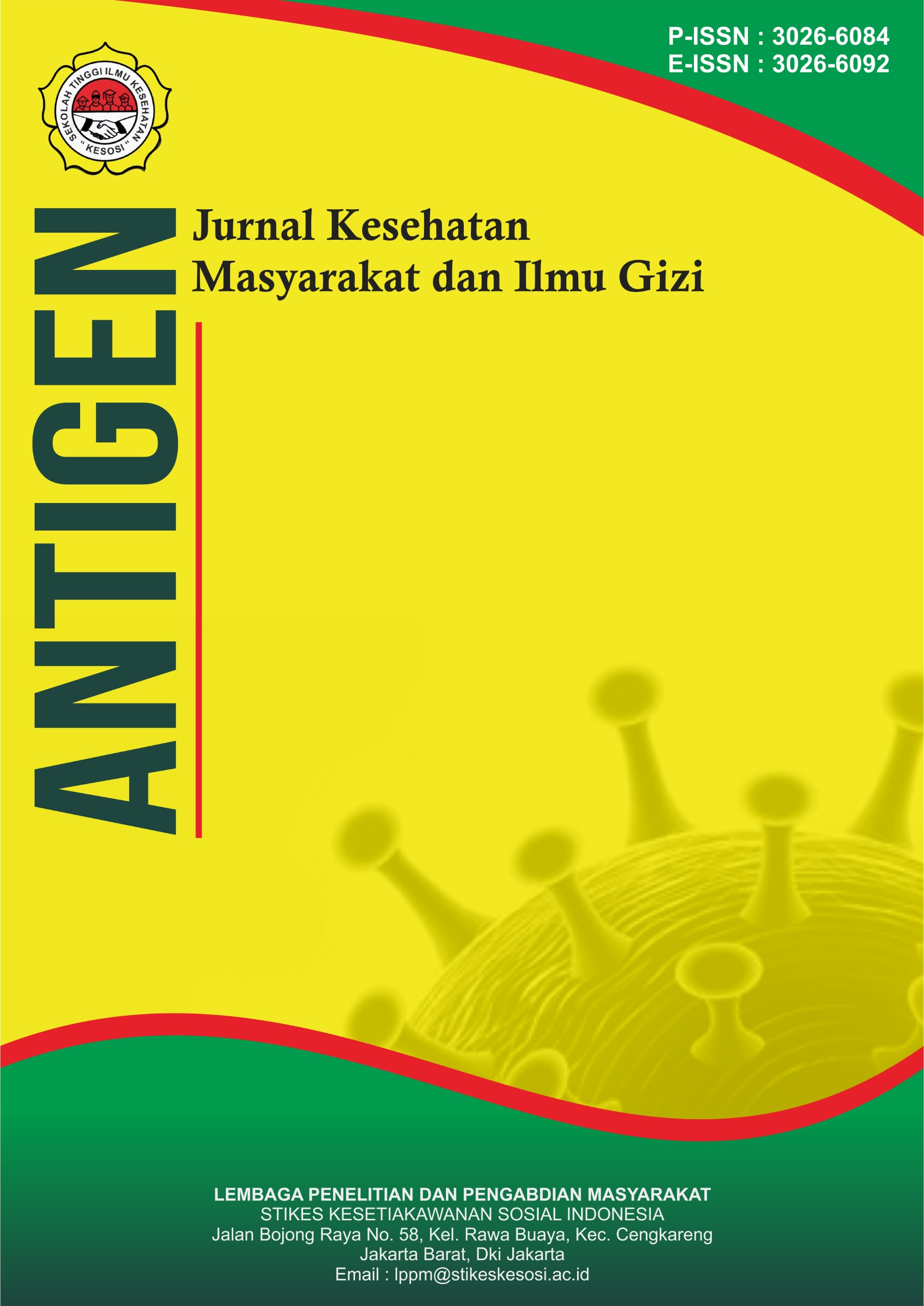Literature Review: The Potential of Tea as an Immunomodulator Through Its Antioxidant and Anti-Inflammatory Properties
DOI:
https://doi.org/10.57213/antigen.v3i3.738Keywords:
Anti-inflammatory, antioxidant, immunodulator, teaAbstract
<p style="text-align: justify;"><em>The immune system is an important mechanism to fight various pathogens. To fight pathogens, external substances are needed to improve performance and prevent pathological impacts of the immune system. Tea is one of the immunomodulatory substances that plays a role in increasing endurance because it has antioxidant and anti-inflammatory functions. This study aims to determine the potential of tea as an immunomodulator through antioxidant and anti-inflammatory mechanisms. The method used is a literature review using scientific articles that are adjusted to the inclusion criteria. Based on the results of the literature review, it shows that tea containing polyphenol compounds has an effect on reducing the levels of inflammatory cytokines such as TNF-α and IL-6 and increasing the activity of antioxidant enzymes (SOD, CAT) and reducing markers of oxidative stress.</em></p>
References
Burhannuddin, B., & Karta, I. W. (2023). Uji aktivitas antiinflamasi teh cang salak secara in vitro dengan metode stabilisasi membran human red blood cell. Jurnal Fitofarmaka Indonesia, 10(2), 39–46.
Griana, T. P., & Kinasih, L. S. (2020, September). Potensi makanan fermentasi khas Indonesia sebagai imunomodulator. Dalam Prosiding Seminar Nasional Biologi (Vol. 6, No. 1, hlm. 401–412).
Harikrishnan, H., Jantan, I., Haque, M. A., & Kumolosasi, E. (2018). Anti-inflammatory effects of hypophyllanthin and niranthin through downregulation of NF-κB/MAPKs/PI3K-Akt signaling pathways. Inflammation, 41(3), 984–995. https://doi.org/10.1007/s10753-018-0759-0
Khan, A., Ali, N. H., Santercole, V., Paglietti, B., Rubino, S., Kazmi, S. U., & Farooqui, A. (2016). Camellia sinensis-mediated enhancement of humoral immunity to particulate and non‐particulate antigens. Phytotherapy Research, 30(1), 41–48. https://doi.org/10.1002/ptr.5510
Lestari, I. C. (2020). Potensi herbal sebagai immunomodulator. Jurnal Kedokteran Ibnu Nafis, 9(2), 33–44.
Mostafa-Hedeab, G., Hassan, M. E., & Halawa, T. F. (2022). Epigallocatechin gallate ameliorates tetrahydrochloride-induced liver toxicity in rats via inhibition of TGFβ/p-ERK/p-Smad1/2 signaling, antioxidant, anti-inflammatory activity. Saudi Pharmaceutical Journal, 30(9), 1293–1300. https://doi.org/10.1016/j.jsps.2022.07.002
Nguyen, T., Payan, B., Zambrano, A., Du, Y., Bondesson, M., & Mohan, C. (2019). Epigallocatechin-3-gallate suppresses neutrophil migration speed in a transgenic zebrafish model accompanied by reduced inflammatory mediators. Journal of Inflammation Research, 231–239. https://doi.org/10.2147/JIR.S200727
Putri, D. U., Rintiswati, N., Soesatyo, M. H., & Haryana, S. M. (2018). Immune modulation properties of herbal plant leaves: Phyllanthus niruri aqueous extract on immune cells of tuberculosis patient—in vitro study. Natural Product Research, 32(4), 463–467. https://doi.org/10.1080/14786419.2017.1344665
Shahzad, F., Anderson, D., & Najafzadeh, M. (2020). The antiviral, anti-inflammatory effects of natural medicinal herbs and mushrooms and SARS-CoV-2 infection. Nutrients, 12(9), 2573. https://doi.org/10.3390/nu12092573
Sharpe, E., Hua, F., Schuckers, S., Andreescu, S., & Bradley, R. (2016). Effects of brewing conditions on the antioxidant capacity of twenty-four commercial green tea varieties. Food Chemistry, 192, 380–387. https://doi.org/10.1016/j.foodchem.2015.07.016
Truong, V. L., & Jeong, W. S. (2021). Cellular defensive mechanisms of tea polyphenols: Structure–activity relationship. International Journal of Molecular Sciences, 22(17), 9109. https://doi.org/10.3390/ijms22179109
Xu, L., Xia, G., Luo, Z., & Liu, S. (2019). UHPLC analysis of major functional components in six types of Chinese teas: Constituent profile and origin consideration. LWT, 102, 52–57. https://doi.org/10.1016/j.lwt.2018.12.056
Yahfoufi, N., Alsadi, N., Jambi, M., & Matar, C. (2018). The immunomodulatory and anti-inflammatory role of polyphenols. Nutrients, 10(11), 1618. https://doi.org/10.3390/nu10111618
Yan, Z., Zhong, Y., Duan, Y., Chen, Q., & Li, F. (2020). Antioxidant mechanism of tea polyphenols and its impact on health benefits. Animal Nutrition, 6(2), 115–123. https://doi.org/10.1016/j.aninu.2020.01.001
Yang, C. S., Chen, G., & Wu, Q. (2014). Recent scientific studies of a traditional Chinese medicine, tea, on prevention of chronic diseases. Journal of Traditional and Complementary Medicine, 4(1), 17–23. https://doi.org/10.4103/2225-4110.124335
Yin, B., Lian, R., Li, Z., Liu, Y., Yang, S., Huang, Z., ... & Li, G. (2021). Tea polyphenols enhanced the antioxidant capacity and induced Hsps to relieve heat stress injury. Oxidative Medicine and Cellular Longevity, 2021, 9615429. https://doi.org/10.1155/2021/9615429
Yuandani, Jantan, I., Ilangkovan, M., Husain, K., & Chan, K. M. (2016). Inhibitory effects of compounds from Phyllanthus amarus on nitric oxide production, lymphocyte proliferation, and cytokine release from phagocytes. Drug Design, Development and Therapy, 1935–1945. https://doi.org/10.2147/DDDT.S103808
Zhang, L., Gui, S., Wang, J., Chen, Q., Zeng, J., Liu, A., ... & Lu, X. (2020). Oral administration of green tea polyphenols (TP) improves ileal injury and intestinal flora disorder in mice with Salmonella typhimurium infection via resisting inflammation, enhancing antioxidant action and preserving tight junction. Journal of Functional Foods, 64, 103654. https://doi.org/10.1016/j.jff.2019.103654
Zhang, S., Xuan, H., Zhang, L., Fu, S., Wang, Y., Yang, H., ... & Wan, X. (2017). TBC2health: A database of experimentally validated health-beneficial effects of tea bioactive compounds. Briefings in Bioinformatics, 18(5), 830–836. https://doi.org/10.1093/bib/bbw060
Zhao, W., Ma, L., Cai, C., & Gong, X. (2019). Caffeine inhibits NLRP3 inflammasome activation by suppressing MAPK/NF-κB and A2aR signaling in LPS-induced THP-1 macrophages. International Journal of Biological Sciences, 15(8), 1571–1581. https://doi.org/10.7150/ijbs.33345
Zhou, T., Zhu, M., & Liang, Z. (2018). (−)-Epigallocatechin-3-gallate modulates peripheral immunity in the MPTP-induced mouse model of Parkinson's disease. Molecular Medicine Reports, 17(4), 4883–4888. https://doi.org/10.3892/mmr.2018.8445
Downloads
Published
Issue
Section
License
Copyright (c) 2025 Antigen : Jurnal Kesehatan Masyarakat dan Ilmu Gizi

This work is licensed under a Creative Commons Attribution-ShareAlike 4.0 International License.






